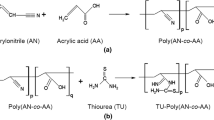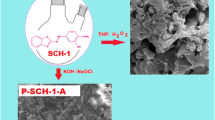Abstract
Two new benzoylthiourea polymers (BTP1/p1–3, BTP2/p2–3) were synthesized via reaction of substituted amines and terephthalodiisothiocyanate which is obtained by the reaction of terephthaloyl dichloride and potassium thiocyanate. As the phase transfer catalyst, poly(ethyleneglycol) dimethylether were tested. Substances 1HNMR,13CNMR, Elemental analysis were characterized. Thermal properties of obtained polymers (p1–3, p2–3) were examined by using TGA-DTG, DTA analysis. It was observed that p1–3 lost 100% of its mass around 750 °C, p2–3 lost 76.52% of its mass around 850 °C. p2–3 showed better thermal stability compared to p1–3. Surface properties of polymers were examined with SEM. Surface area of benzoylthiourea polymers was measured by using the BET. A BET surface areas of 14.280 m2/g and 12.691 m2/g and was found for p1–3 and p2–3 (300 K), respectively and total pore volumes are 2,77 × 10−1 cm3/g and 4,90 × 10−1 cm3/g. Degradation reactions, mass losses, melting and decomposition points were determined by analysing curves. The mercury retention properties of the insoluble polymeric p1–3, p2–3 were analyzed by equilibrium reactions. The synthesized polymers also act as high-impact sorbents/sensors in the removal of trace amounts of Hg2+. In this study, it was observed that ~99,7% mercury from environmental sources such as water can be removed with low amount of resin despite the moderate BET surface area (when the resin surface areas after the modification of inorganic and organic polymers with thiourea were examined). In addition, the new benzoylthiourea polymers can be synthesized in 100% high yield. This study proposes the versatility of microporous benzoylthiourea polymers targeting various environmental challenges for the separation and detection of toxic metals. Although the basic structure of these compounds is considered as chromophore, oxochrome groups, aromatic rings and resonance structures and their electronic properties, photoluminescence/electroluminescence radiations could not be determined because the substances did not dissolve.










Similar content being viewed by others
References
Zuo G, Muhammed M (2007) Extraction of mercury (II) by thiourea- based reagents. Solvent Extr Ion Exch 13:855–878
Fu Y, Yu W, Zhang W, Huang Q, Yan J, Pan C, Yu G (2018) Sulfur-rich covalent Triazine polymer Nanospheres for environmental mercury removal and detection. Polym Chem:1–7. https://doi.org/10.1039/C8PY00419F
Chen D, Liu C, Tang J, Luo L, Yu G (2019) Fluorescent porous organic polymers. Polym Chem:1–12. https://doi.org/10.1039/C8PY01620H
Jiang JX, Su F, Trewin A, Wood CD, Campbell NL, Niu H (2008). Angew Chem 47:8574–8578
Budd PM, Ghanem BS, Makhseed S, Mckeown NB, Msayib KJ, Tattershall CE (2004). Chem Commun (2):230–231
Ghanem, B.S., 2012, A facile synthesis of a novel triptycene-containing A–B monomer: precursor to polymers of intrinsic microporosity, 3,96–98, DOI: https://doi.org/10.1039/C1PY00423A
Lu W (2016) Strategies for hydrogen storage in porous organic polymers. Nanostructured Materials for Next-Generation Energy Storage and Conversion:203–223
Banihashemi A, Hazarkhani H, Abdolmaleki A (2004) Efficient and rapid synthesis of Polyureas and Polythioureas from the reaction of urea and Thiourea with diamines under microwave irradiation. J Polym Sci A Polym Chem 42:2106–2111
Wei TB, Zhang YM, Gao LM (2000) An efficient synthesis of Polymethylene bis-aroyl Thiourea derivatives under the condition of phase transfer catalysis. Synth Commun 30(3):493–500
Tsurutani N, Miyaji H, Izumi K, Tasaka S (1997) Direct proof of chain rotation on polarization reversal of amorphous poly(nonamethylene thiourea) by X-ray anomalous scattering. Polymer 38(12):2881–2884
Klayman DL, Shine RJ, Bower JD (1972). J Org Chem 37:1532±1537
Koch K (2001) New chemistry with old ligands: N-alkyl- and N,N-dialkyl-NI - acyl (aroyl)thioureas in coordination, analytical and process chemistry of the platinum group metals. Coord Chem Rev 216–217:473–488
Kodomari M, Suzuki M, Tanigawa K, Aoyama T (2005) A convenient and efficient method for the synthesis of mono and N,Nı-disubstituted thioureas. Tetrahedron Lett 46:5841–5843
Kaymakçıoğlu B, Rollas S, Körcegez E, Arıcıoğlu F (2005) Synthesis and biological evaluation of new N-substituted-N-(3,5-di/1,3,5-trimethylpyrazole-4-yl) thiourea/ urea derivatives. Eur J Pharm Sci 26:97–103
Yang W, Liu H, Li M, Wang F, Zhou W, Fan J (2012) Synthesis, structures and antibacterial activities of benzoylthiourea derivatives and their complexes with cobalt. J Inorg Biochem 116:97–105
Xu X, Qian X, Lİ Z, Huang Q, Chen G (2003) Synthesis and insecticidal activity of new substituted N-aryl-N′-benzoylthiourea compounds. J Fluor Chem 121:51–54
Rether A, Schuster M (2003) Selective separation and recovery of heavy metal ions using water-soluble N-benzoylthiourea modified PAMAM polymers. Reactive & Functional Polymers 57:13–21
Fontas C, Hidalgo M, Salvado V, Antico E (2005) Selective recovery and preconcentration of mercury with benzoylthiourea-solid supported liquid membrane system. Anal Chim Acta 547:255–261
Androvič L, Drabina P, Svobodova M, Sedlak M (2016) "Polystyrene supported benzoylthiourea—pyrrolidine organocatalyst for the enantioselective" Michael addition. Tetrahedron Asymmetry 27(16):782–787
Daniel Z, Motoko W, George YB (2013) Theoretical study on the thermal decomposition of thiourea. Comput Theor Chem 1017:91–98
Wagner P, Niemczyk-Baltoro S, Kubicki M (2003) N-Benzoylthiourea. Acta Crystallogr Sect C: Cryst Struct Commun 59(2):o83–o84
Chitra R, Das A, Coudhurry RR, Ramanadham M, Lakshmi S, Sridhar MA, Prasad SJ (2005) Hydrogen bonding in thiourea: diethyl oxalate complex in 2:1 ratio. J Chem Crystallogr 35:7
Mohamed NA, Al-mehbad NY (2013) Novel terephthaloyl thiourea cross-linked chitosan hydrogels as antibacterial and antifungal agents. Int J Biol Macromol 57:111–117
Barragan P, Macedo MG, Olguin MT (2017) Cadmium sorption by sodium and thiourea-modified zeolite-rich tuffs. J Environ Sci 52:39–48
Kaplan DJ, Larsen S, Serkiz SM, Seaman JC (2016) Functionalized magnetic mesoporous silica nanoparticles for U removal from low and high pH groundwater. J Hazard Mater 317:494–502
Liu B, Zou RQ, Zhong RQ, Han S, Shioyama H, Yamada T, Maruta G, Takeda S, Xu Q (2008) Microporous coordination polymers of cobalt(II) and manganese(II) 2,6-naphthalenedicarboxylate: preparations, structures and gas sorptive and magnetic properties. Microporous Mesoporous Mater 111:470–477
Ranganathan R, Anbanandam P (2015) Soluble microporous ladder polymers formed by stepwise nucleophilic substitution of octafluorocyclopentene. Polym Chem 6:1–4
Yeşilkaynak T, Muslu H, Özpınar C, Emen FM, Demirdöğen RE, Külcü N (2017) Novel thiourea derivative and its complexes: synthesis, characterization, DFT computations, thermal and electrochemical behavior, antioxidant and antitumor activities. J Mol Struct 1142:185–193
Chaoui N, Trunk M, Dawson R, Schmidta J, Thomas A (2017) Trends and challenges for microporous polymers. Chem Soc Rev 46:3302
Acknowledgements
The author acknowledge the financial support provided by Aksaray University under scientific and technological research unit (Project No:2012/06).
Author information
Authors and Affiliations
Corresponding author
Additional information
Publisher’s note
Springer Nature remains neutral with regard to jurisdictional claims in published maps and institutional affiliations.
Rights and permissions
About this article
Cite this article
Kurt, G. Synthesis of new poly-benzoylthiourea and thermal and surface properties. J Polym Res 26, 232 (2019). https://doi.org/10.1007/s10965-019-1845-y
Received:
Accepted:
Published:
DOI: https://doi.org/10.1007/s10965-019-1845-y




